Topic Modeling Analysis of Children’s Food Safety Management Using BigKinds News Big Data: Comparing the Implementation Times of the Comprehensive Plan for Children’s Dietary Safety Management
Abstract
1. Introduction
2. Materials and Methods
2.1. Data Collection
2.2. Data Analysis
2.2.1. Preprocessing
2.2.2. Topic Modeling and Determination of the Number of Topics
2.2.3. Visualizing Topics: LDAvis
3. Results
3.1. LDA Analysis Results for Child Food Safety
3.2. Topic-Based Analysis of Trends in the “Comprehensive Plans for Safety Management of Children’s Dietary Life”
4. Discussion
5. Conclusions
Author Contributions
Funding
Institutional Review Board Statement
Informed Consent Statement
Data Availability Statement
Conflicts of Interest
Abbreviations
| AI | Artificial Intelligence |
| LDA | Latent Dirichlet Allocation |
References
- Shim, J.E. Picky Eating and Factors Affecting Food Acceptance. J. East Asian Soc. Diet. Life 2021, 31, 1–13. [Google Scholar] [CrossRef]
- Greenthal, E.; Marx, K.; Friedman, E.; John, S.; Johnson, J.; LiPuma, C.; Nara, D.; Sorscher, S.; Gardner, K.; Musicus, A. Navigating the online food environment: Policy pathways for promoting food access, transparency, and healthy food choices online. Front. Nutr. 2024, 11, 1473303. [Google Scholar] [CrossRef]
- Granheim, S.I.; Løvhaug, A.L.; Terragni, L.; Torheim, L.E.; Thurston, M. Mapping the digital food environment: A systematic scoping review. Obes. Rev. 2022, 23, e13356. [Google Scholar] [CrossRef] [PubMed]
- Paluta, L.; Kaiser, M.L.; Huber-Krum, S.; Wheeler, J. Evaluating the impact of a healthy corner store initiative on food access domains. Eval. Program Plann. 2019, 73, 24–32. [Google Scholar] [CrossRef] [PubMed]
- Vesoulis, Z.A.; Husain, A.N.; Cole, F.S. Improving child health through Big Data and data science. Pediatr. Res. 2023, 93, 342–349. [Google Scholar] [CrossRef]
- Ministry of Food and Drug Safety (MFDS). Report on the Pilot Operation of Health Food Corners in Convenience Stores; Ministry of Food and Drug Safety (MFDS): Cheongju-si, Republic of Korea, 2023. Available online: https://impfood.mfds.go.kr/CFBBB02F02/getCntntsDetail?cntntsSn=566353 (accessed on 5 February 2025).
- Joamets, K. Children’s right to healthy food and the digital market—Need for legal and policy development. Balt. J. Eur. Stud. 2024, 14, 240–254. [Google Scholar]
- Baranowski, M. Epistemological aspect of topic modelling in the social sciences: Latent Dirichlet Allocation. Przegląd Kryt. 2022, 4, 7–16. [Google Scholar] [CrossRef]
- Jang, S.Y.; Jung, S.H. An Analysis of the Research Trends for Urban Study using Topic Modeling. J. Korea Acad.-Ind. Coop. Soc. 2021, 22, 661–670. [Google Scholar]
- Kim, S.Y. Discovering Policy Implications from Analysis of News Big-data Related to Digital Issues Based on LDA Topic-modeling. Korean Public Adm. Q. 2023, 35, 499–523. [Google Scholar] [CrossRef]
- Alhashmi, M.; Maree, M.; Saadeddin, Z. Using Latent Dirichlet Allocation and Text Mining Techniques for Understanding Medical Literature. Int. J. Comput. 2021, 20, 506–512. [Google Scholar] [CrossRef]
- Park, S.K.; Lee, B.G. A Text Mining Approach to the Analysis of Issues for Accommodation Sharing Business. J. Tour. Leis. Res. 2019, 31, 209–229. [Google Scholar] [CrossRef]
- Kim, K.H.; Jun, C.S.; Song, C.H.; Jeon, J.H. Patent Trend Analysis of Unmanned Ground Vehicles(UGV) using Topic Modeling. J. KIMST 2024, 27, 395–405. [Google Scholar] [CrossRef]
- Kim, E.J.; Choi, H.J. Analyzing Core Tehnology and Technological Convergence in Healthcare Using Topic Modeling and Network Analysis: Focus on Patent Information. J. Korea Inst. Inf. Commun. Eng. 2022, 26, 763–778. [Google Scholar]
- Lee, S.S.; Yoo, I.H.; Kim, J.H. An analysis of public perception on Artificial Intelligence (AI) education using Big Data: Based on News articles and Twitter. J. Digit. Converg. 2020, 18, 9–16. [Google Scholar]
- Song, C.; Guo, C.; Hunt, K.; Zhuang, J. An Analysis of Public Opinions Regarding Take-Away Food Safety: A 2015–2018 Case Study on Sina Weibo. Foods 2020, 9, 511. [Google Scholar] [CrossRef] [PubMed]
- Song, C.; Guo, J.; Gholizadeh, F.; Zhuang, J. Quantitative Analysis of Food Safety Policy—Based on Text Mining Methods. Foods 2022, 11, 3421. [Google Scholar] [CrossRef]
- Barkho, L. For a postfoundational method to news discourse analysis. Cogent Arts Humanit. 2023, 10, 2185446. [Google Scholar] [CrossRef]
- Park, S.K.; Lee, H.J.; Lee, B.G. Exploring Social Issues of On-demand Delivery Platform Participants. J. Digit. Converg. 2021, 19, 79–85. [Google Scholar]
- Gebhard, L.; Hamborg, F. The POLUSA Dataset: 0.9M Political News Articles Balanced by Time and Outlet Popularity. In Proceedings of the ACM/IEEE Joint Conference on Digital Libraries in 2020, Virtual Event, China, 1–5 August 2020; Association for Computing Machinery: New York, NY, USA; 2020; pp. 467–468. [Google Scholar]
- Ittefaq, M.; Zain, A.; Arif, R.; Ala-Uddin, M.; Ahmad, T.; Iqbal, A. Global news media coverage of artificial intelligence (AI): A comparative analysis of frames, sentiments, and trends across 12 countries. Telemat. Inform. 2025, 96, 102223. [Google Scholar] [CrossRef]
- Chen, S.; Ngai, C.S.B.; Cheng, C.; Hu, Y. Analyzing Themes, Sentiments, and Coping Strategies Regarding Online News Coverage of Depression in Hong Kong: Mixed Methods Study. J. Med. Internet Res. 2025, 27, e66696. [Google Scholar] [CrossRef] [PubMed]
- Choi, Y.J.; Um, Y.J. Topic Models to Analyze Disaster-Related Newspaper Articles: Focusing on COVID-19. Int. J. Ment. Health Promot. 2023, 25, 421–431. [Google Scholar] [CrossRef]
- Seo, J.W.; Koh, S.K. Trends in the issues of housewives in newspaper articles using topic modeling based on big data. J. Fam. Better Life 2023, 41, 95–114. [Google Scholar] [CrossRef]
- Cha, Y.R. Big Data Analysis of Metaverse and Advertising related to News Articles: Focusing on Topic Modeling. J. Pract. Res. Advert. Public Relat. 2023, 16, 159–179. [Google Scholar]
- Cho, S.G.; Park, H.J. Analysis of Consumer Food Safety Issues Due to COVID-19; National Food Safety Information Service (NFSIS): Cheongju-si, Republic of Korea, 2023; p. 26.
- Park, G.T.; Im, S.H.; Kim, M.S.; Choi, D.H.; Song, B.M. Analysis of Key Topics in Green Logistics Using LDA—Focusing on Keywords Before and After the COVID-19. J. Korean Prod. Oper. Manag. Soc. 2022, 33, 463–479. [Google Scholar]
- Park, S.U.; Kang, J.Y.; Jung, S.C. Complete Guide to Python Text Mining: From Natural Language Processing Basics to Deep Learning-Based BERT Models; Wikibook: Paju, Republic of Korea, 2022. [Google Scholar]
- Sievert, C.; Shirley, K. LDAvis: A Method for Visualizing and Interpreting Topics. In Proceedings of the Workshop on Interactive Language Learning, Visualization, and Interfaces, Baltimore, MD, USA, 27 June 2014; pp. 63–70. [Google Scholar]
- Gencoglu, B.; Helms-Lorenz, M.; Maulana, R.; Jansen, E.P.; Gencoglu, O. Machine and expert judgments of student perceptions of teaching behavior in secondary education: Added value of topic modeling with big data. Comput. Educ. 2023, 193, 104682. [Google Scholar] [CrossRef]
- Ferdinand, B.J.; Aviarta, N.P.; Jordan, M.G.; Purwandari, K. Topic Identification of Science and Mathematics Literature Using Latent Dirichlet Allocation. In Proceedings of the 2024 IEEE International Conference on Artificial Intelligence and Mechatronics Systems (AIMS), Bandung, Indonesia, 21–23 February 2024; pp. 1–5. [Google Scholar] [CrossRef]
- Kim, H.O.; Park, H.S.; Hong, D.Y. Subalternity of Refugee Women: Focused on the Semantic Connectivity and Topic Analysis of English Literature on Refugee Women. J. Crit. Soc. Welf. 2024, 84, 97–133. [Google Scholar] [CrossRef]
- Chuang, J.; Manning, C.D.; Heer, J. Termite: Visualization techniques for assessing textual topic models. In Proceedings of the International Working Conference on Advanced Visual Interfaces, Capri Island, Italy, 21–25 May 2012; pp. 74–77. [Google Scholar]
- de Sousa, R.F.; Balcerzak, A.; Bevere, T.; de Quadros, V.P. FAO/WHO GIFT: Increasing the availability, harmonization and use of individual quantitative food consumption data worldwide. Eur. J. Public Health 2020, 30, ckaa165-768. [Google Scholar]
- Barnes, C.; Yoong, S.L.; Nathan, N.; Wolfenden, L.; Wedesweiler, T.; Kerr, J.; Ward, D.S.; Grady, A. Feasibility of a Web-Based Implementation Intervention to Improve Child Dietary Intake in Early Childhood Education and Care: Pilot Randomized Controlled Trial. J. Med. Internet Res. 2021, 23, e25902. [Google Scholar] [CrossRef]
- Ministry of Food and Drug Safety. The 5th Children’s Dietary Safety Management Comprehensive Plan (2022~2024); Ministry of Food and Drug Safety: Cheongju-si, Republic of Korea, 2025. Available online: https://www.mfds.go.kr/brd/m_218/view.do?seq=33432 (accessed on 5 February 2025).
- Kim, H.Y.; Kim, D.J.; Lee, Y.S.; Lim, S.T.; Cho, J.H. The Effect of Participation in Public Health Center Mobile Health Care Service for on Health Physical Fitness of Elementary-Middle Students. Korean J. Growth Dev. 2023, 31, 145–151. [Google Scholar] [CrossRef]
- Laur, C.; Johnsen, J.T.; Bradfield, J.; Eden, T.; Mitra, S.; Ray, S. Closing the Gap: Data-Based Decisions in Food, Nutrition and Health Systems: Proceedings of the Fifth International Summit on Medical and Public Health Nutrition Education and Research. BMJ Nutr Prev. Health 2020, 3, 397–402. [Google Scholar] [CrossRef]
- Laperriere, A.; Bohn, J.; do Vale, M.L. 5 Data-Driven Action for Food Systems Transformation. BMJ Nutr. Prev. Health 2022. [Google Scholar]
- Kim, S.Y. A Study of Food Behavior and Food Purchasing Behavior of High School Students According to Frequency of Use of Convenience Stores. Master’s Thesis, Jeonbuk National University, Jeonju, Republic of Korea, 2021. [Google Scholar]
- Park, H.; Kang, H.; Lee, E.S.; Lee, H. The snacking pattern, diet, lifestyle and menu preferences of elementary school students in Gyeonggi area, considering the most frequently eaten snacks. J. Nutr. Health 2021, 54, 547–559. [Google Scholar] [CrossRef]
- Rhodes, D.; Morton, S.; Moshfegh, A. Convenience Stores: Source of Food/Beverages Among Children, What We Eat in America, NHANES, 2015–2018. Curr. Dev. Nutr. 2021, 5, 1086. [Google Scholar] [CrossRef]
- Department of Health of UK. Change4Life Convenience Stores Evaluation Report 2010; Department of Health of UK: London, UK, 2010; pp. 1–34.
- Boyland, E.; McGale, L.; Maden, M.; Hounsome, J.; Boland, A.; Jones, A. Systematic review of the effect of policies to restrict the marketing of foods and non-alcoholic beverages to which children are exposed. Obes. Rev. 2022, 23, e13447. [Google Scholar] [CrossRef] [PubMed]
- Lee, H.S.; Kim, J.H. Analysis of Food Consumption Behavior due to COVID-19: Focusing on MZ Generation. J. Digit. Converg. 2021, 19, 47–54. [Google Scholar]
- Shen, C.; Wei, M.; Sheng, Y. A bibliometric analysis of food safety governance research from 1999 to 2019. Food Sci. Nutr. 2021, 9, 2316–2334. [Google Scholar] [CrossRef]
- Saavedra, J.M. The Changing Landscape of Children’s Diet and Nutrition: New Threats, New Opportunities. Ann. Nutr. Metab. 2022, 78, 40–50. [Google Scholar] [CrossRef]
- Salmon, K.; Shin, D.; Kmush, B.; Wallia, B.; Bellows, A.; Larsen, D. Evidence of declining dietary diversity among children aged 1–5 years between 2005 and 2017 in lower-income countries. Curr. Dev. Nutr. 2020, 4, nzaa046_061. [Google Scholar] [CrossRef]
- Eichenbaum, M.; Rebelo, S.; Trabandt, M. Epidemics in the Neoclassical and New-Keynesian Models; NBER Working Paper; National Bureau of Economic Research: Cambridge, MA, USA, 2020; p. 2 7430.
- Campello, M.; Kankanhalli, G.; Muthukrishnan, P. Corporate hiring under COVID-19: Financial constraints and the nature of new jobs. J. Financ. Quant. Anal. 2023, 59, 1–79. [Google Scholar] [CrossRef]
- Silva, F.B.G. Fiscal Deficits, Bank Credit Risk, and Loan-Loss Provisions. J. Financ. Quant. Anal. 2021, 56, 1537–1589. [Google Scholar] [CrossRef]
- Bloom, N. The impact of uncertainty shocks. Econometrica 2009, 77, 623–685. [Google Scholar] [CrossRef]
- Campello, M.; Cortes, G.S.; d’Almeida, F.; Kankanhalli, G. Exporting uncertainty: The impact of Brexit on corporate America. J. Financ. Quant. Anal. 2022, 57, 3178–3222. [Google Scholar] [CrossRef]
- Campello, M.; Kankanhalli, G.; Kim, H. Delayed creative destruction: How uncertainty shapes corporate assets. J. Financ. Econ. 2024, 153, 103786. [Google Scholar] [CrossRef]
- Dantas, M. Are ESG Funds More Transparent? SSRN. 2021. Available online: https://papers.ssrn.com/sol3/papers.cfm?abstract_id=3269939 (accessed on 13 July 2025).
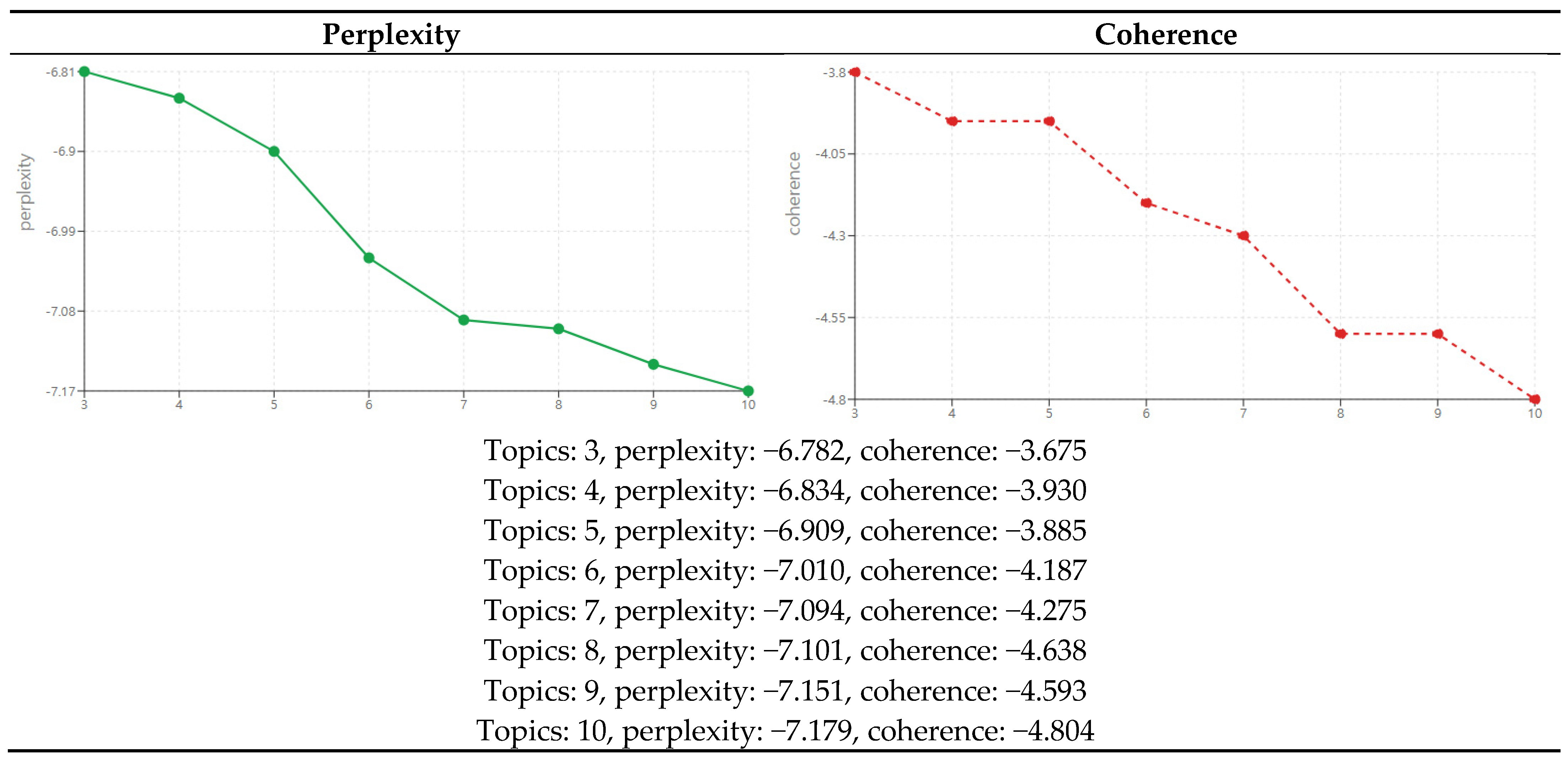
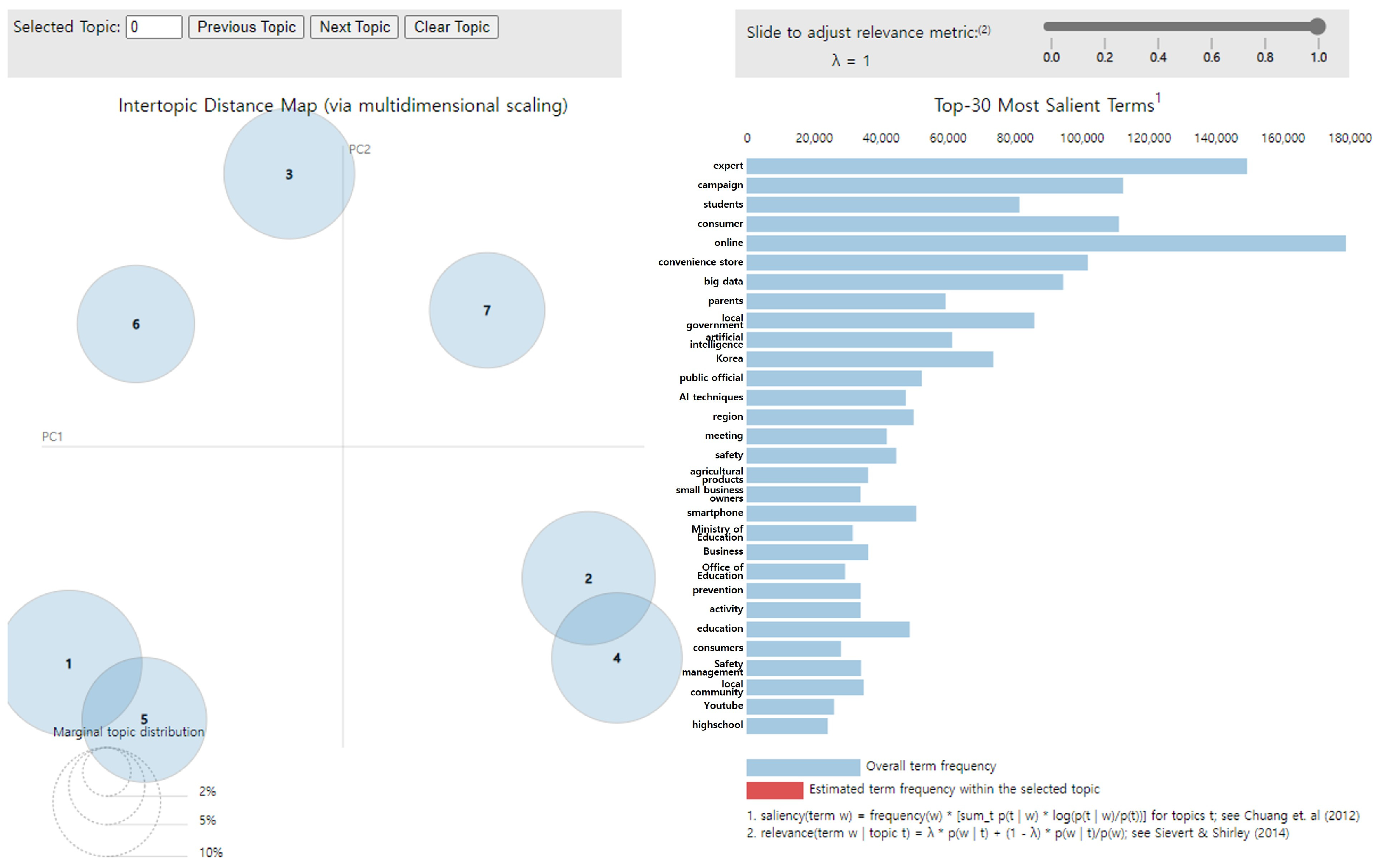
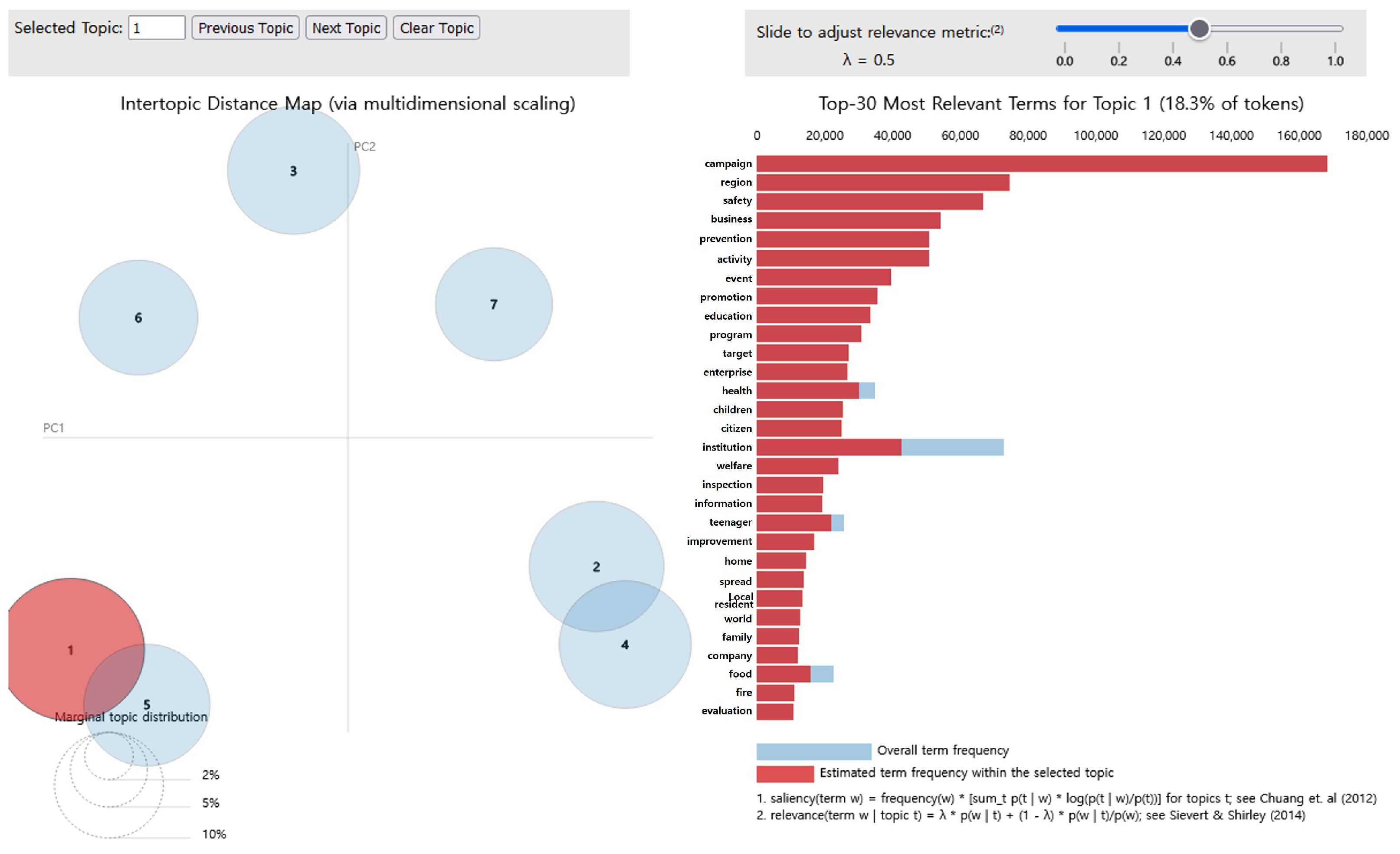
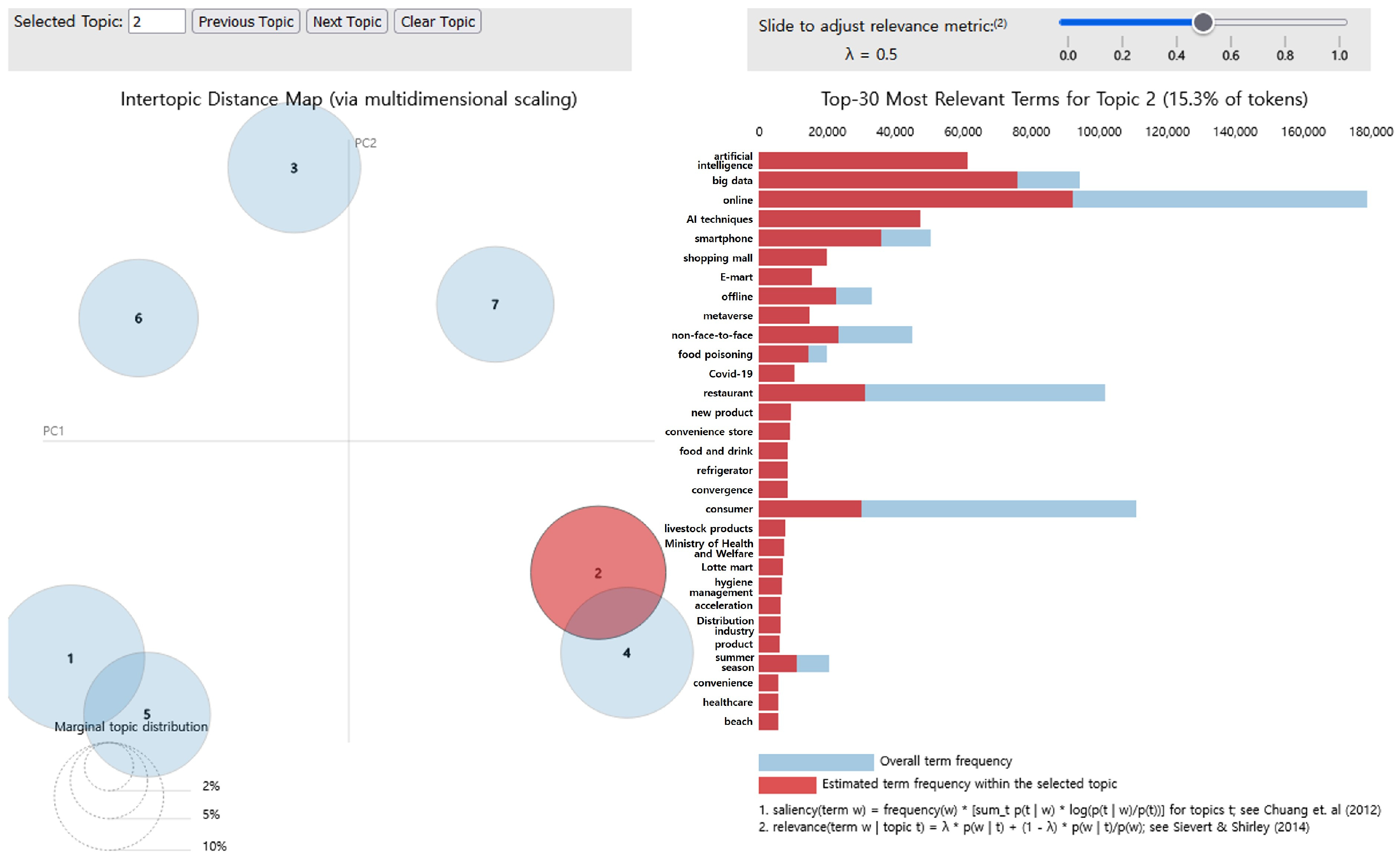
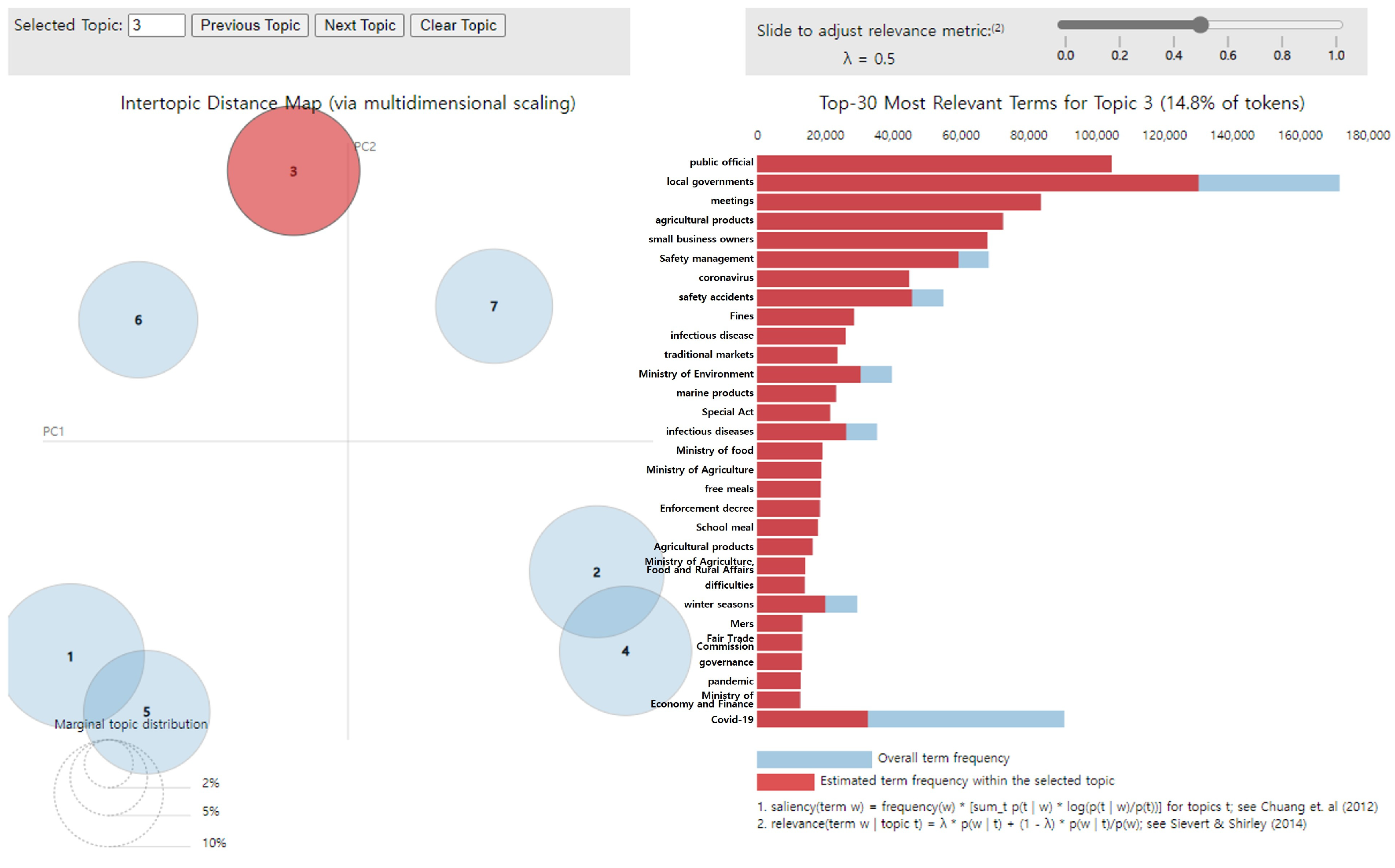
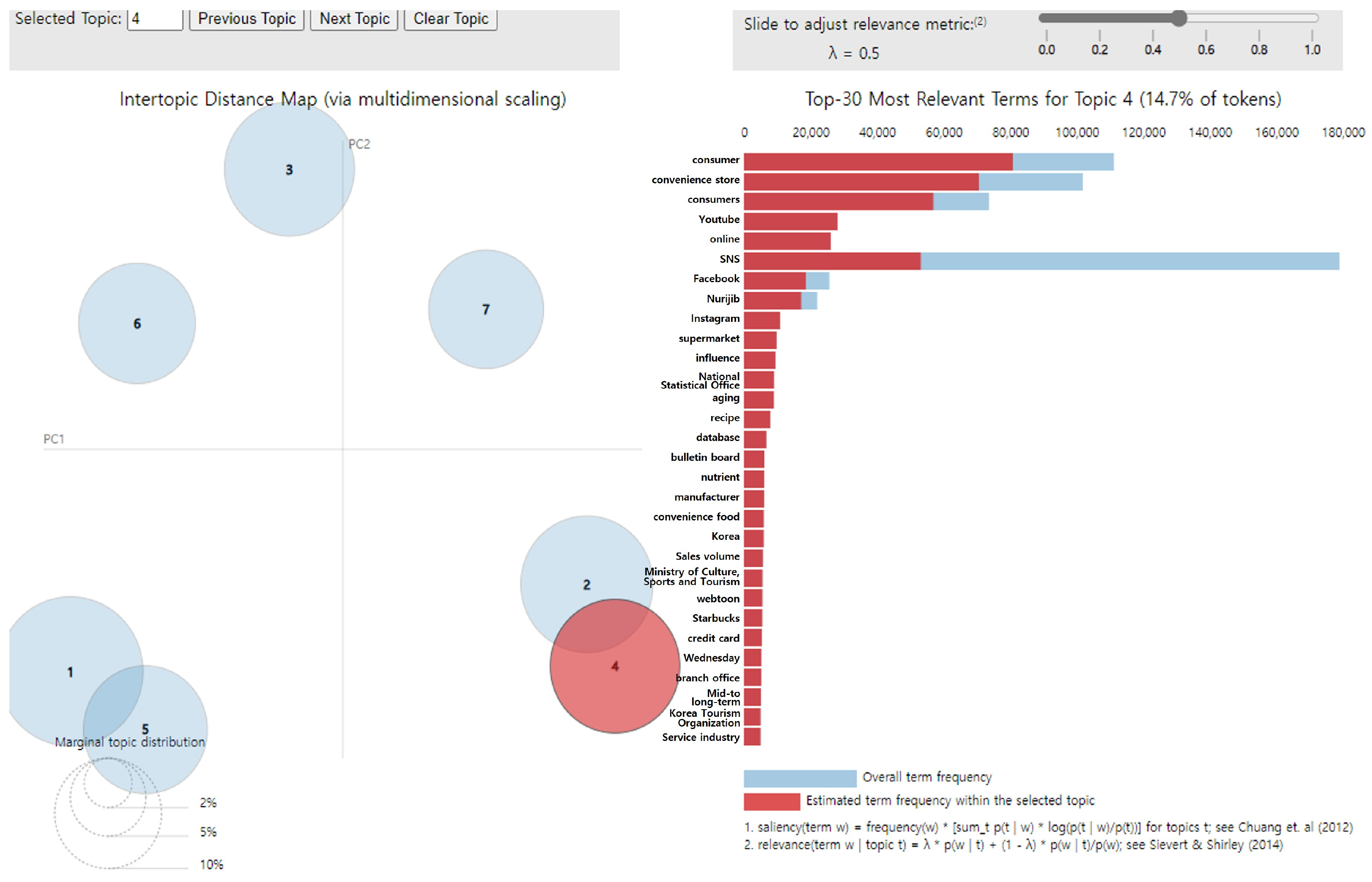

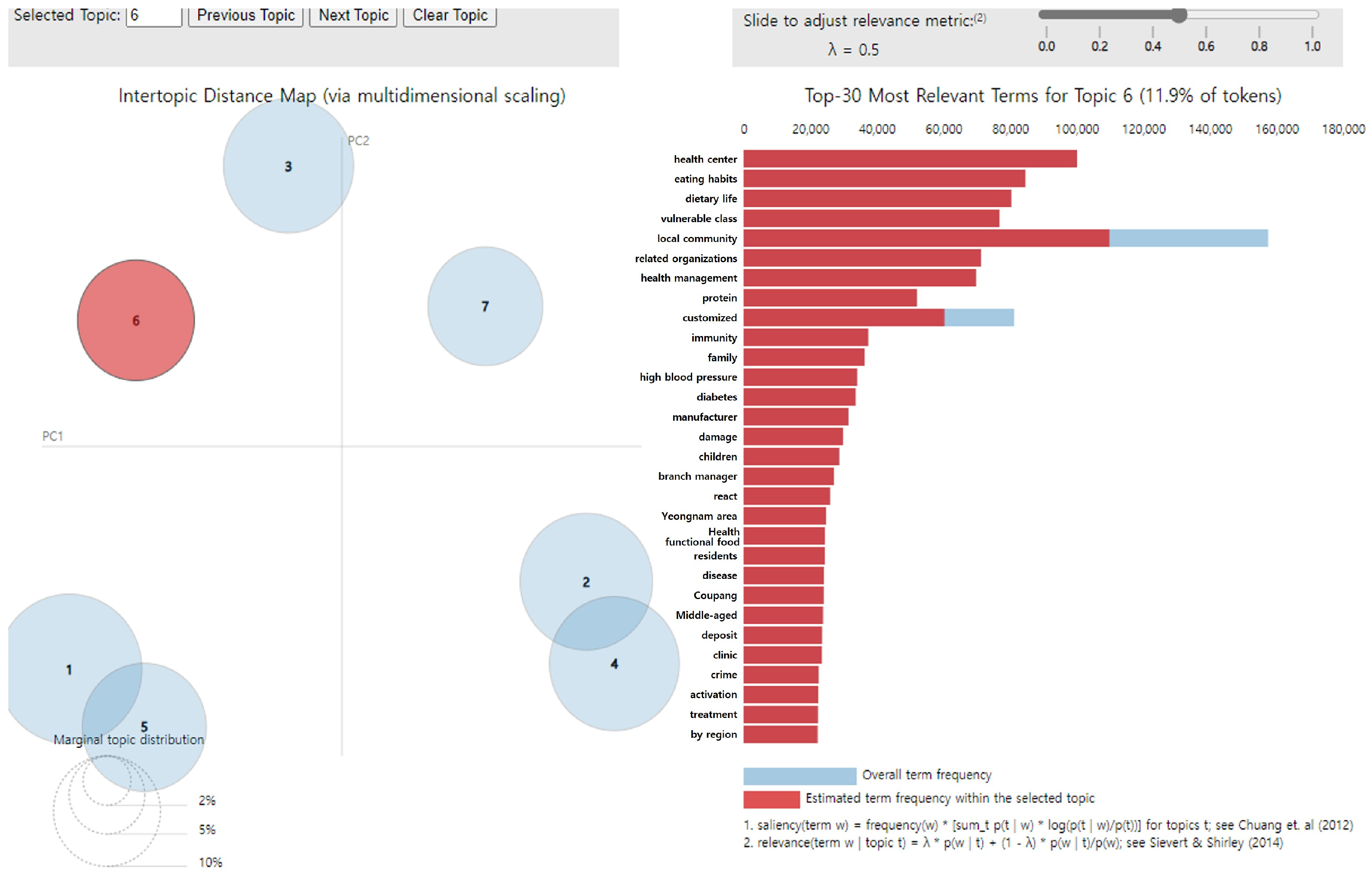
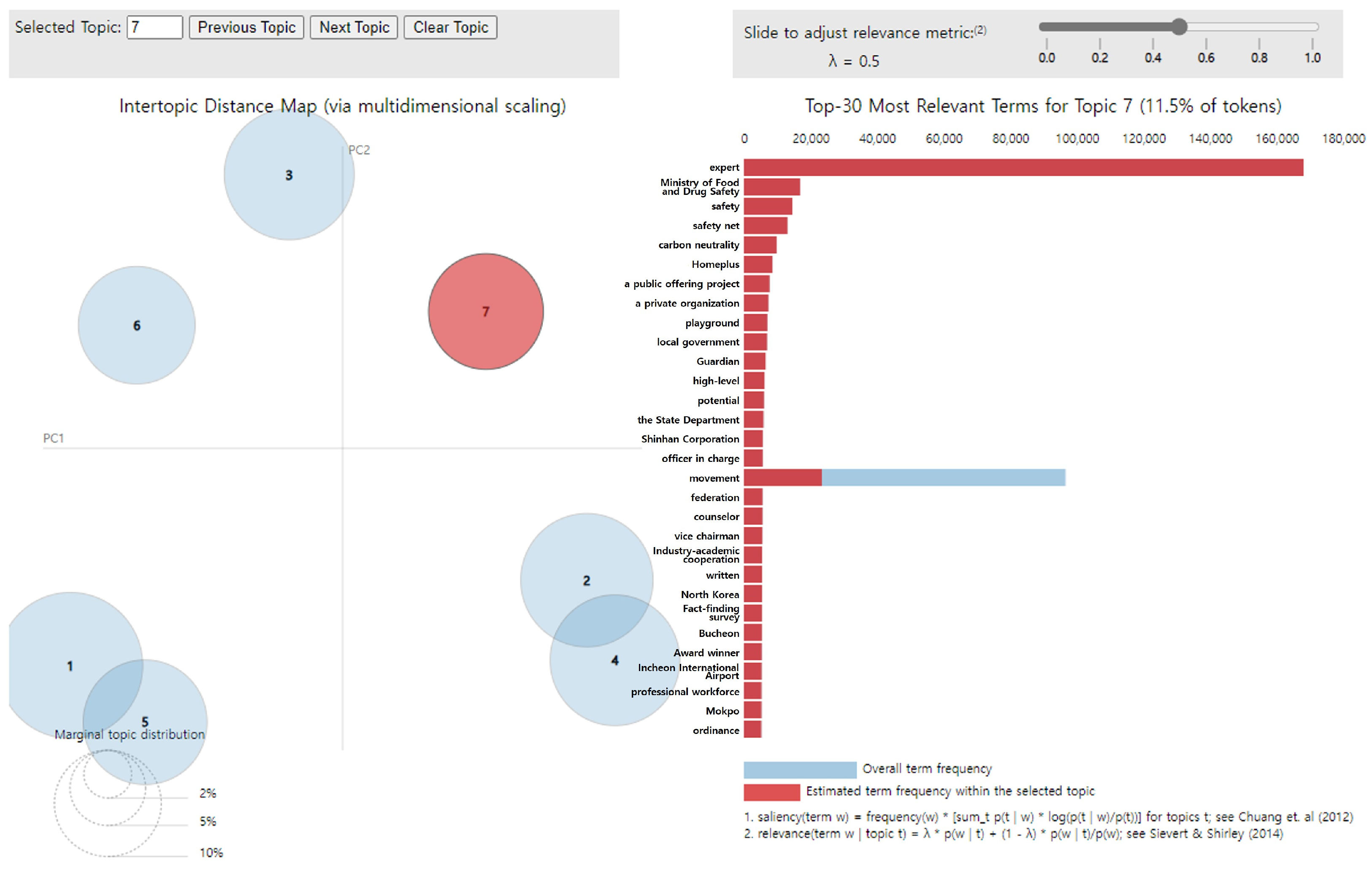
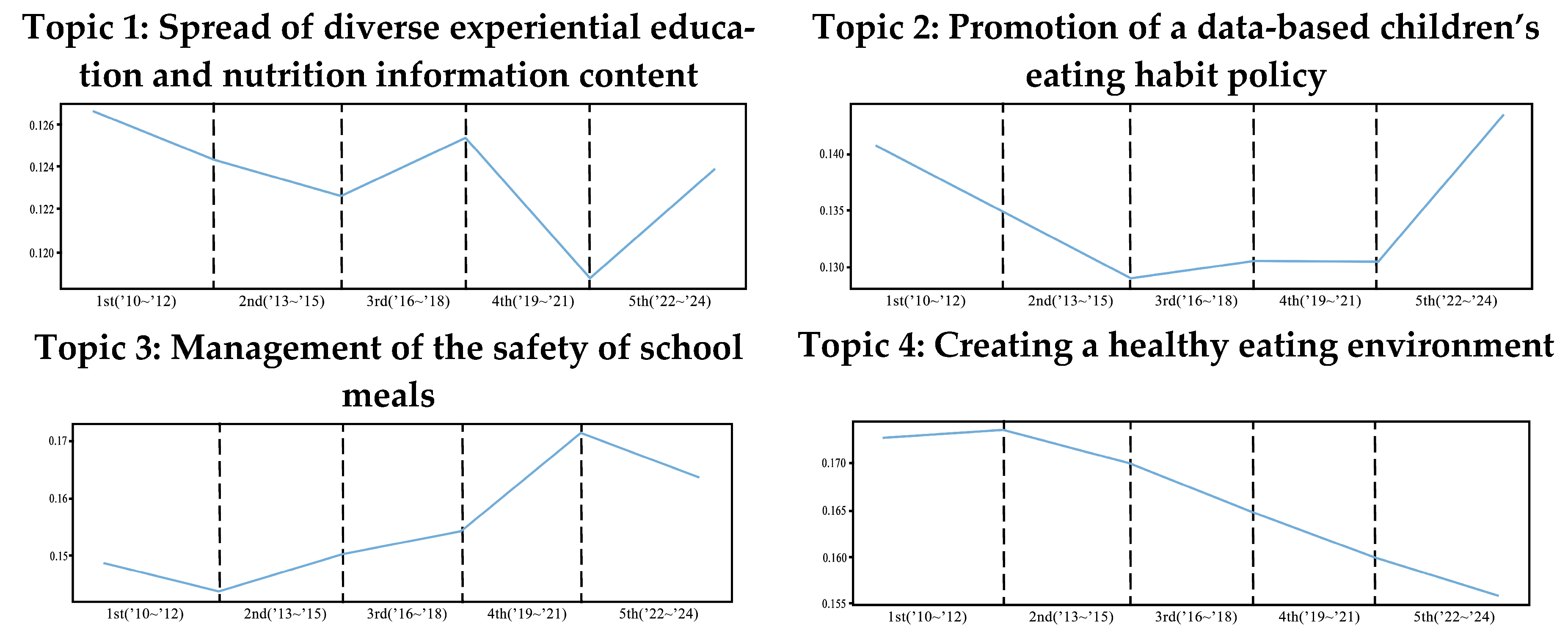
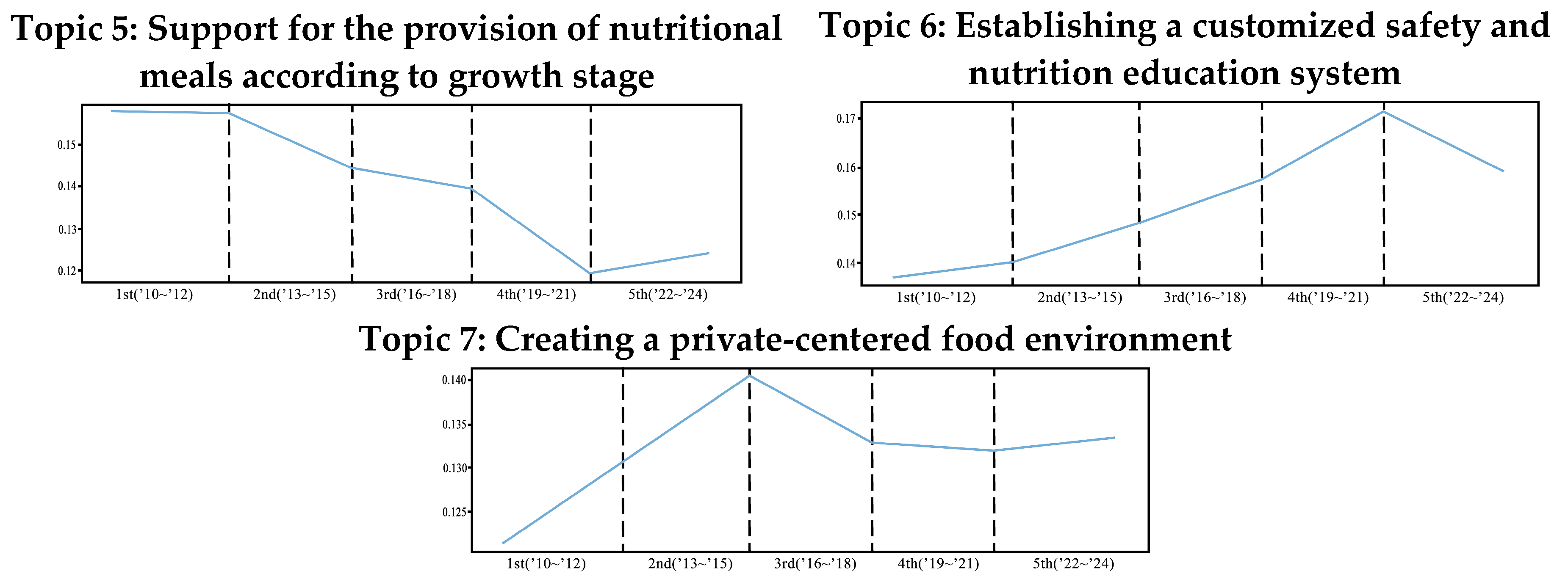
| Author | Year | Article |
|---|---|---|
| Ittefaq M, Zain A, Arif R, Ala-Uddin M, Ahmad T, Iqbal A [21] | 2025 | Global news media coverage of artificial intelligence (AI): A comparative analysis of frames, sentiments, and trends across 12 countries |
| Chen S, Ngai CSB, Cheng C, Hu Y [22] | 2025 | Analyzing Themes, Sentiments, and Coping Strategies Regarding Online News Coverage of Depression in Hong Kong: Mixed Methods Study |
| Choi YJ, Um YJ [23] | 2023 | Topic Models to Analyze Disaster-Related Newspaper Articles: Focusing on COVID-19 |
| Kim SY [10] | 2023 | Discovering Policy Implications from Analysis of News Big-data Related to Digital Issues Based on LDA Topic-modeling |
| Seo JW, Koh SK [24] | 2023 | Trends in the issues of housewives in newspaper articles using topic modeling based on big data |
| Cha YR [25] | 2023 | Big Data Analysis of Metaverse and Advertising related to News Articles: Focusing on Topic Modeling |
| No. | 1st (2010–2012) | 2nd (2013–2015) | 3rd (2016–2018) | 4th (2019–2021) | 5th (2022–2024) | |||||
|---|---|---|---|---|---|---|---|---|---|---|
| Keyword | N | Keyword | N | Keyword | N | Keyword | N | Keyword | N | |
| 1 | campaign | 28,388 | online | 51,204 | big data | 51,208 | online | 140,490 | online | 80,583 |
| 2 | consumer | 27,527 | convenience store | 36,719 | online | 46,808 | big data | 68,375 | artificial intelligence | 59,140 |
| 3 | online | 27,355 | consumer | 36,692 | consumer | 42,639 | consumer | 59,586 | local government | 52,477 |
| 4 | convenience store | 23,358 | campaign | 34,916 | convenience store | 41,637 | local government | 54,536 | consumer | 45,284 |
| 5 | students | 17,725 | big data | 22,962 | campaign | 36,705 | convenience store | 51,543 | convenience store | 42,840 |
| 6 | local government | 14,675 | local government | 22,401 | local government | 30,970 | artificial intelligence | 43,520 | big data | 41,783 |
| 7 | support | 10,457 | students | 21,712 | students | 24,216 | campaign | 43,166 | parents | 38,824 |
| 8 | agricultural products | 9760 | support | 13,200 | artificial intelligence | 19,452 | students | 37,333 | students | 34,568 |
| 9 | parents | 9464 | parents | 11,411 | support | 17,067 | AI techniques | 35,296 | campaign | 33,816 |
| 10 | education | 8939 | safety | 11,340 | AI techniques | 15,632 | parents | 26,530 | AI techniques | 30,172 |
| 11 | medicine | 8602 | agricultural products | 11,220 | safety | 13,280 | support | 23,211 | supply chain | 20,011 |
| 12 | management | 8329 | safety management | 10,866 | education | 13,204 | infection | 21,743 | support | 19,885 |
| 13 | participation | 7390 | education | 10,714 | parents | 12,563 | local community | 20,525 | local community | 19,098 |
| 14 | safety | 7387 | Mers | 10,672 | safety management | 12,481 | infectious diseases | 20,516 | safety management | 17,827 |
| 15 | free meals | 7231 | management | 10,355 | agricultural products | 11,650 | agricultural products | 19,870 | education | 16,578 |
| 16 | prevention | 6945 | medicine | 9605 | management | 11,511 | education | 17,021 | safety accident | 14,243 |
| 17 | eating habits | 5888 | prevention | 9371 | medicine | 10,937 | medicine | 15,901 | agricultural products | 14,057 |
| 18 | school | 5866 | institutes street | 9198 | local community | 10,765 | safety management | 15,729 | safety | 13,813 |
| 19 | cooperation | 5841 | safety accident | 8520 | prevention | 10,016 | safety | 15,053 | medicine | 12,998 |
| 20 | children | 5770 | participation | 8503 | participation | 9900 | high school | 13,472 | high school | 12,527 |
Disclaimer/Publisher’s Note: The statements, opinions and data contained in all publications are solely those of the individual author(s) and contributor(s) and not of MDPI and/or the editor(s). MDPI and/or the editor(s) disclaim responsibility for any injury to people or property resulting from any ideas, methods, instructions or products referred to in the content. |
© 2025 by the authors. Licensee MDPI, Basel, Switzerland. This article is an open access article distributed under the terms and conditions of the Creative Commons Attribution (CC BY) license (https://creativecommons.org/licenses/by/4.0/).
Share and Cite
Park, H.J.; Cho, S.G.; Lee, K.W.; Lee, S.J.; Oh, J. Topic Modeling Analysis of Children’s Food Safety Management Using BigKinds News Big Data: Comparing the Implementation Times of the Comprehensive Plan for Children’s Dietary Safety Management. Foods 2025, 14, 2650. https://doi.org/10.3390/foods14152650
Park HJ, Cho SG, Lee KW, Lee SJ, Oh J. Topic Modeling Analysis of Children’s Food Safety Management Using BigKinds News Big Data: Comparing the Implementation Times of the Comprehensive Plan for Children’s Dietary Safety Management. Foods. 2025; 14(15):2650. https://doi.org/10.3390/foods14152650
Chicago/Turabian StylePark, Hae Jin, Sang Goo Cho, Kyung Won Lee, Seung Jae Lee, and Jieun Oh. 2025. "Topic Modeling Analysis of Children’s Food Safety Management Using BigKinds News Big Data: Comparing the Implementation Times of the Comprehensive Plan for Children’s Dietary Safety Management" Foods 14, no. 15: 2650. https://doi.org/10.3390/foods14152650
APA StylePark, H. J., Cho, S. G., Lee, K. W., Lee, S. J., & Oh, J. (2025). Topic Modeling Analysis of Children’s Food Safety Management Using BigKinds News Big Data: Comparing the Implementation Times of the Comprehensive Plan for Children’s Dietary Safety Management. Foods, 14(15), 2650. https://doi.org/10.3390/foods14152650






